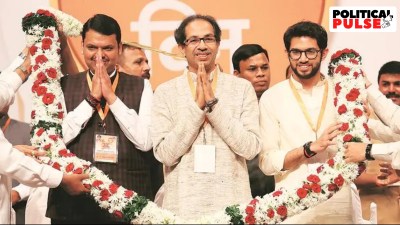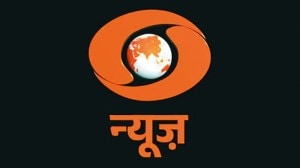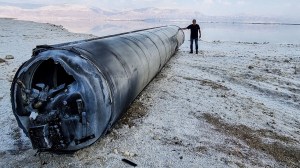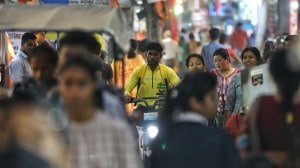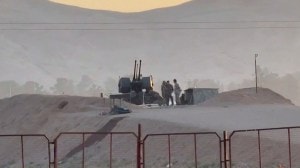- India
- International
World’s largest recruitment drive: ‘It appears the entire country is here’
The Railways is hiring for 1.2 lakh jobs, and applications are flooding in from across the country. This is nearly 20 years after a call had been taken to cut staff numbers. The Indian Express on a hiring exercise that began with a government on backfoot over safety, and will end in time for the next elections
 Lal flips through his well-thumbed copy of ‘Arihant Railway Exam Group D — Solved Papers’ before the exam
Lal flips through his well-thumbed copy of ‘Arihant Railway Exam Group D — Solved Papers’ before the exam
ONE OF THE world’s largest employers, India’s largest employer, holding “the world’s largest recruitment drive”, at a cost of around Rs 800 crore, to sift through 2.37 crore applicants, to hire 1.2 lakh.
Nothing about the ongoing drive by the Indian Railways to fill up vacancies is small.
For the second time in almost two years, the national transporter is hiring to fill up vacancies on a large scale, from assistant loco pilots and technicians to gangmen and trackmen.
So that more and more could apply, an earlier decision requiring applicants for Group D to have an ITI (Industrial Training Institute) certificate along with education up to at least till Class X has been reversed. Besides, the age limit, that was earlier 28 years for assistant loco pilots and technicians and 31 years for Group D, has been increased by two years. Announcing the changes last year, Railway Minister Piyush Goyal had said making ITI a must excluded a huge number of aspirants, which was “unfair”.
Read | World’s largest recruitment drive 2,37,00,000: ‘It appears the entire country is here’

“We need to fill up existing vacancies in the safety category posts. Our services have increased manifold, so has the pressure on the system for maintenance. This massive recruitment drive is crucial in that respect,” says Chairman, Railway Board, Ashwani Lohani.
Both Goyal and Lohani took charge last year following a spate of derailments, resulting in deaths. The one accident immediately before the shake-up was the derailment of the Kalinga Utkal Express at Khatauli, Uttar Pradesh, blamed on negligence of railway staff, that killed 23 and injured 156. Every accident in the Railways usually brings to light its thousands of vacancies, ranging from trackmen to loco pilots.
The new dispensation of Lohani and Goyal was hence under added pressure to improve the patchy Railway safety record. The decision to fill the backlog of safety-category vacancies was taken immediately after they took charge, in September 2017. The current recruitment is filling up vacancies accumulated over the past four years, especially in Group D categories.
However, the past few years the Railways has been in two minds over whether to fill up these vacancies, and by how much. And for good reason.
While the recruitment drive may set a global record, it will also set the fragile finances of the transporter back by an estimated Rs 4,000 crore per year in staff costs alone, apart from the Rs 800-odd crore cost of the recruitment process. After the 7th Central Pay Commission, the Railways staff cost for this financial year is around Rs 76,000 crore, up from around Rs 71,000 crore in the last fiscal.
 Preeti Devi, one of two women candidates in the evening shift at the Noida centre
Preeti Devi, one of two women candidates in the evening shift at the Noida centre
Salaries are paid from revenue and the Railways is struggling to keep its Operating Ratio (money spent to earn every Rs 100, and hence the lower the better) under 100 per cent. It ended 2017-18 at 98.5 per cent, its worst-ever performance. Around 45,000 people retire every year, but not all are needed to be replaced. In a day and age of increased mechanisation and computerisation of processes, organisations like a railway system may require less and less people to achieve the same productivity. To cut down overheads, government organisations also rely on outsourcing of jobs through service contracts, so that manpower costs do not weigh its finances down. The Railways is no different.
But officials say some manpower needs are organic and inescapable. “Even if there are machines, we need people to operate those machines. We need more and more loco pilots to run trains as our services are increasing. Over time, vacancies had increased a lot. All this have a direct bearing on safety,” says a Railway Board member.
For the Indian Railways, this is in a way going back on its manpower management philosophy, committed to the government of the day in the late ’90s. Following the implementation of the 5th Central Pay Commission, a Railway Board report to the government had ascertained that considering global trends in technology in railway systems, the manpower-heavy Indian Railways, with around 16 lakh on its rolls at the time, needed to become a leaner organisation to keep its finances in shape. Other railway systems were studied and it was found that China carried four times more freight over a significantly larger network but employed only around 8 lakh people.
The plan put in motion, approved by the government, was to gradually bring down the rail employee numbers to 14 lakh in five years and 12 lakh in 10 years. The ultimate goal was somewhere around 8 lakh, in phases. As a result, by 2009-10, the number of employees had fallen below 14 lakh.
But then came Mamata Banerjee as railway minister under the UPA-II government. Much like the present NDA administration, Mamata too wanted to fill up safety-category vacancies, especially in Group D. The result was that 1.67 lakh vacancies were prepared to be filled.
In a country where a government job is many things rolled into one — security, a house, permanence for over 30 years in a person’s life — there is much to desire about employment with the Central government. This is especially true at the lower levels, as Group D- and C-equivalent jobs in the private sector are fraught with uncertainty and do not pay half as much. “A significant portion of the jobs created in the services sector over the past couple of decades have been in traditional low-value-added services, where informality and vulnerable forms of employment are often dominant,” says the 2018 World Employment and Social Outlook Trends report of the International Labour Organisation.
The last recruitment drive by the Railways, held around February 2017, was also the world’s largest at the time. It advertised for 18,252 posts of assistant station master, inquiry-cum-reservation clerk, traffic and commercial apprentices and junior accounts assistant, and received 92 lakh applications, of which 2.73 lakh qualified to take the test. That process, a fraction of the current jobs drive, had gone on for three days of examination in shifts.
This time, 440 exam centres in 116 cities have been seeing around 5 lakh take the computer test every exam day. In August, 47.56 lakh candidates from across India took the test for 26,502 vacancies in Group C category, including assistant loco pilots, technicians etc. The ongoing phase, for Group D posts, will go on till December, with 1.9 crore applying for 62,907 posts.
Like the last time, IT major Tata Consultancy Services has been roped in to design the computer tests. While the 21 Railway Recruitment Boards are conducting the exams in their jurisdictions, the Railway Ministry itself has for years had just a lone officer managing all the big and small recruitment drives. It is only recently that another officer was posted to supplement him.
After the tests, the Railways will disclose the answer key to each question paper. To check cheating, every question paper’s sequence and thus answer key is different. Candidates will be shown their answer sheets and will have a chance to raise objections, to be adjudged by a committee of teachers. This process will take a month.
The successful candidates will next take a Physical Efficiency Test, which is expected to take another month or so, followed by a medical test and verification of documents that might take another couple of months.
By the time the new recruits are posted, it will be not earlier than May. Just in time for the next elections that the Modi government heads into, with its promise of jobs.
Apr 20: Latest News
- 01
- 02
- 03
- 04
- 05











